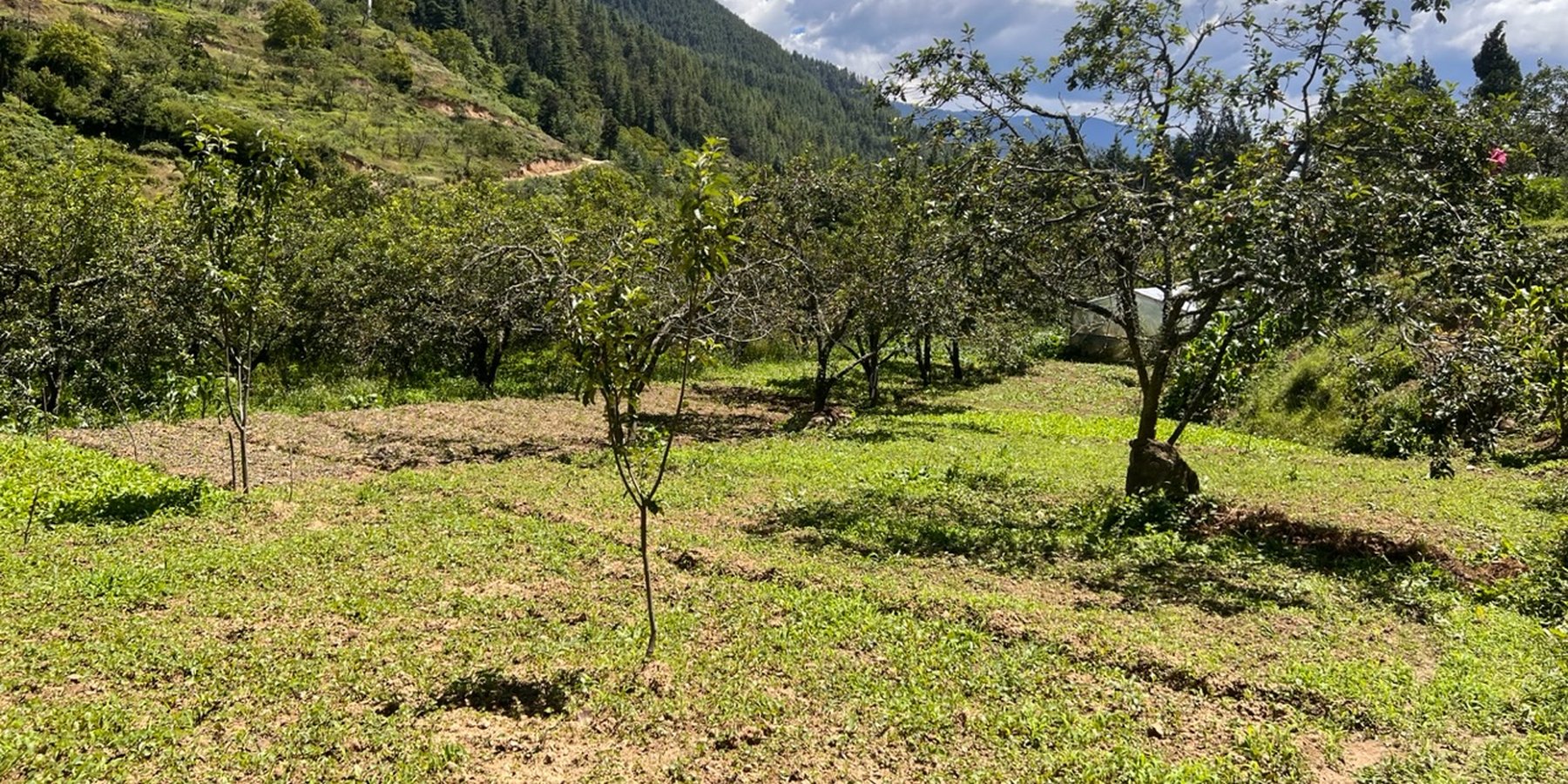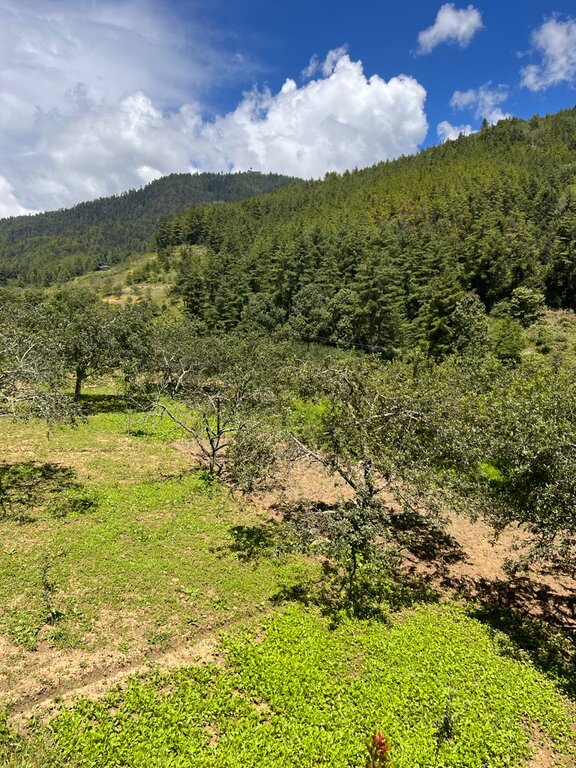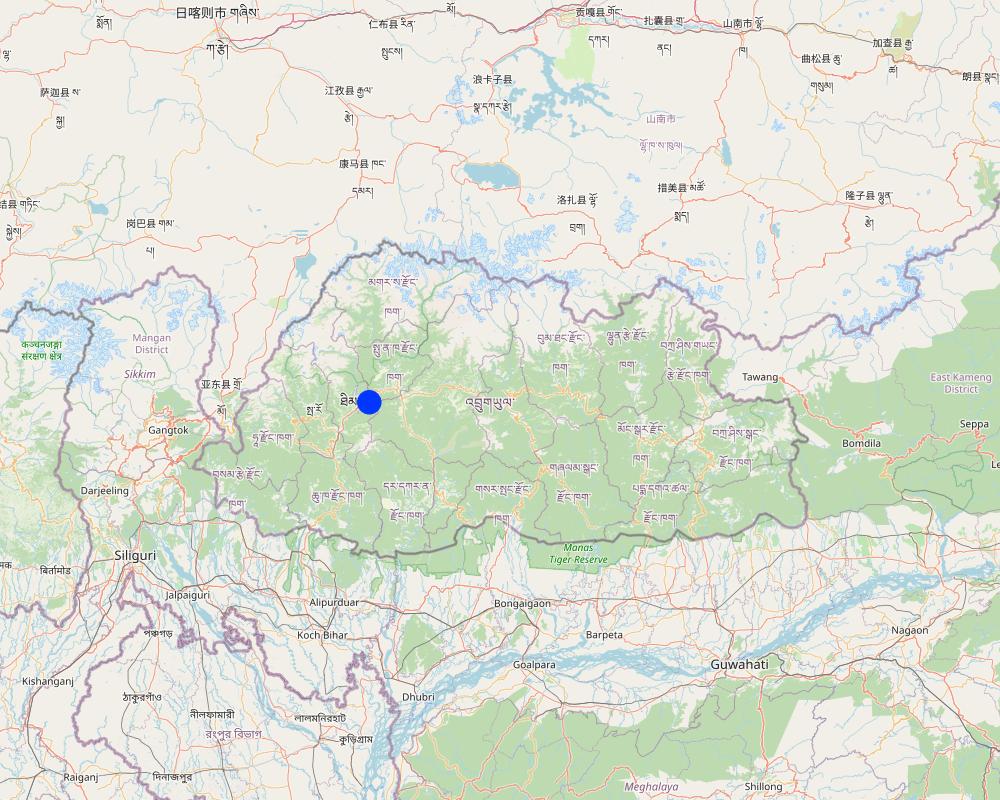Vegetable Intercropping in Apple Orchards [不丹]
- 创建:
- 更新:
- 编制者: Tshering Yangzom
- 编辑者: Kuenzang Nima
- 审查者: William Critchley, Rima Mekdaschi Studer, Joana Eichenberger
Apple Dhum Ra Nang Tshoe Sey La Sey Tsug Ni (ཨེ་པཱལ་ལྡུམ་ར་ནང་ཚོད་བསྲེ་སླ་བསྲེ་བཙུགས་ནི་།)
technologies_6844 - 不丹
查看章节
全部展开 全部收起1. 一般信息
1.2 参与该技术评估和文件编制的资源人员和机构的联系方式
关键资源人
土地使用者:
Sharman Rai
n/a
不丹
有助于对技术进行记录/评估的项目名称(如相关)
Strengthening national-level institutional and professional capacities of country Parties towards enhanced UNCCD monitoring and reporting – GEF 7 EA Umbrella II (GEF 7 UNCCD Enabling Activities_Umbrella II)有助于对技术进行记录/评估的机构名称(如相关)
National Soil Services Center, Department of Agric (National Soil Services Center, Department of Agric) - 不丹1.3 关于使用通过WOCAT记录的数据的条件
编制者和关键资源人员接受有关使用通过WOCAT记录数据的条件。:
是
1.4 所述技术的可持续性声明
这里所描述的技术在土地退化方面是否存在问题,导致无法被认为是一种可持续的土地管理技术?:
否
2. SLM技术的说明
2.1 技术简介
技术定义:
Vegetables are intercropped between fruit-bearing trees in orchards. This maximizes land utilization, increases agrobiodiversity, and optimizes agricultural productivity.
2.2 技术的详细说明
说明:
Intercropping of vegetables with fruit-bearing trees in orchards can be an effective system in terms of production and agroecology. It is a sustainable farming technique that optimizes land use, increases agrobiodiversity, diversifies production, and enhances overall yields. Land users in Yusipang grow peas, beans, and cole crops (cabbages, kale, etc.) in their apple orchards.
Intercropping vegetables in orchard land optimizes the use of space, sunlight, water and nutrients. Intercropping also increases biodiversity within the orchard ecosystem. This coexistence of species reduces the vulnerability of the orchard to crop failure and pest infestation: it improves the residence of the overall system.
Trees in the system absorb nutrients from the soil and return them through fallen leaves, thereby improving soil fertility and reducing reliance on external fertilizers. This nutrient recycling improves the overall health of the orchard ecosystem. Intercropping can also help in natural pest management through various mechanisms – including the attraction of beneficial insects - thus reducing the need for chemical pesticides. It also fosters a beneficial microclimate.
To establish intercropping of vegetables in orchards, careful planning and design is required with respect to crop selection, spacing of trees and intercrops, irrigation, and nutrient management. Regular weeding and mulching are required alongside adequate irrigation, integrated pest management, and pruning of fruit trees to prevent competition for light and space.
Intercropping of vegetables in orchards thus offers multiple benefits to farmers and the overall agricultural system, including increased farm productivity. It increases climate resilience and improves the health of the agroecosystem. However, it is important to be aware of potential drawbacks. These include competition between crops for resources - and labour. Sound management practices can overcome these challenges and maximize the effectiveness of intercropping.
2.3 技术照片
2.4 技术视频
位置:
n/a
2.5 已应用该技术的、本评估所涵盖的国家/地区/地点
国家:
不丹
区域/州/省:
Thimphu
有关地点的进一步说明:
Yusipang, Chang Gewog, Thimphu Dzongkhag
具体说明该技术的分布:
- 均匀地分布在一个区域
如果技术均匀分布在一个区域,则指定覆盖的区域(单位为平方千米):
0.4
技术现场是否位于永久保护区?:
否
注释:
The area does not fall under any protected area or parks.
Map
×2.6 实施日期
如果不知道确切的年份,请说明大概的日期:
- 10-50年前
2.7 技术介绍
详细说明该技术是如何引入的:
- 作为传统系统的一部分(> 50 年)
3. SLM技术的分类
3.1 该技术的主要目的
- 减少、预防、恢复土地退化
- 保护生态系统
- 保持/提高生物多样性
- 降低灾害风险
- 创造有益的经济影响
3.2 应用该技术的当前土地利用类型
同一土地单元内混合使用的土地::
是
具体说明混合土地使用(作物/放牧/树木):
- 农林业

农田
- 一年一作
- 乔木与灌木的种植
年作 - 具体指明作物:
- 蔬菜 - 其他
- 蔬菜 - 根茎类蔬菜(胡萝卜、洋葱、甜菜等)
- Cole crops, chili, beans, peas
每年的生长季节数:
- 1
采用间作制度了吗?:
是
如果是,说明哪些作物是间作的:
Vegetables and fruit trees are intercropped.
采用轮作制度了吗?:
是
如果是,请具体说明:
Vegetables are rotated in the orchard.
3.3 由于技术的实施,土地使用是否发生了变化?
由于技术的实施,土地使用是否发生了变化?:
- 否(继续问题3.4)
3.4 供水
该技术所应用土地的供水:
- 混合雨水灌溉
3.5 该技术所属的SLM组
- 农业林学
- 轮作制度(轮作、休耕、轮垦)
- 改良的地面/植被覆盖
3.6 包含该技术的可持续土地管理措施

农艺措施
- A1:植被和土壤覆盖层
3.7 该技术强调的主要土地退化类型

土壤水蚀
- Wt:表土流失/地表侵蚀
- Wg:冲沟侵蚀/沟蚀

土壤风蚀
- Et:表土流失

物理性土壤退化
- Pc:压实
- Ps:有机土壤沉降,土壤沉降

生物性退化
- Bc:植被覆盖的减少
3.8 防止、减少或恢复土地退化
具体数量名该技术与土地退化有关的目标:
- 防止土地退化
- 减少土地退化
4. 技术规范、实施活动、投入和成本
4.1 该技术的技术图纸
4.2 有关投入和成本计算的一般信息
具体说明成本和投入是如何计算的:
- 每个技术区域
注明尺寸和面积单位:
1 acre
如果使用本地面积单位,注明转换系数为1公顷(例如1公顷=2.47英亩):1公顷=:
1 acre
其它/国家货币(具体说明):
BTN
如相关,注明美元与当地货币的汇率(例如1美元=79.9巴西雷亚尔):1美元=:
81.0
注明雇用劳工的每日平均工资成本:
Nu. 800
4.3 技术建立活动
| 活动 | 时间(季度) | |
|---|---|---|
| 1. | Assess the orchard: Evaluate the orchard's existing conditions, including soil fertility, drainage, sunlight availability, and pest and disease history. This assessment will help determine the feasibility and suitability of intercropping vegetables in the orchard. | Anytime |
| 2. | Select compatible vegetable crops: Choose vegetable crops that are compatible with the existing fruit trees in terms of their growth requirements, sunlight tolerance, water needs, and harvesting periods. Consider crops that are less competitive and can thrive in the orchard's microclimate. | Year-round |
| 3. | Plan the intercropping layout: Develop a planting design that optimises space utilisation and resource distribution. Consider factors such as crop spacing, row orientation, and the arrangement of vegetable crops within the orchard. Ensure that the intercropped vegetables are positioned to minimise shading and competition with the fruit trees. | Anytime |
| 4. | Prepare the soil: Prior to planting, prepare the soil by clearing any existing vegetation and weeds. Conduct soil testing to assess nutrient levels and pH, and amend the soil if necessary to create optimal growing conditions for both the vegetables and fruit trees. | Spring |
| 5. | Implement irrigation systems: Install or adapt irrigation systems to accommodate the intercropped vegetables' water requirements. Consider the water needs of both the vegetables and fruit trees when determining irrigation frequency and duration. | Anytime |
| 6. | Manage nutrients: Determine the nutrient requirements of the intercropped vegetables and fruit trees. Based on soil test results, develop a fertilization plan that addresses the nutritional needs of both crops. Apply organic or synthetic fertilizers as appropriate, considering the specific nutrient requirements of each crop. | Anytime |
| 7. | Implement pest and disease management strategies: Develop an integrated pest management (IPM) plan to control pests and diseases effectively. Monitor the orchard regularly for signs of pests or diseases and take appropriate preventive or corrective actions, such as using natural predators, applying organic pesticides, or practising cultural methods like crop rotation. | After plantation |
| 8. | Weed management: Employ weed control measures to minimise competition between the vegetables and fruit trees. This can include mulching the soil around plants, practising regular manual weeding, or using targeted herbicides that are safe for both crops. | After plantation |
| 9. | Monitor and adjust: Continuously monitor the growth and performance of both the vegetables and fruit trees throughout the growing season. Make necessary adjustments to irrigation, fertilisation, pest control, and other management practices based on observations and the specific needs of each crop. | Year-round |
4.4 技术建立所需要的费用和投入
如果您无法分解上表中的成本,请估算建立该技术所需要的总成本。:
23000.0
如果土地使用者负担的费用少于100%,请注明由谁负担其余费用:
The land users bore 100% of costs.
注释:
Taking into consideration the labour charge for layout making, pit digging, pit filling, use of equipment such as spades and crowbars, and plantation of fruit trees and then some seasonal vegetables in between the fruit trees in 1 ac of land, the approximate cost of establishment is Nu 23000 (USD 284).
4.6 维护/经常性活动所需要的费用和投入(每年)
如果您无法分解上表中的成本,请估算维护该技术所需要的总成本。:
6000.0
如果土地使用者负担的费用少于100%,请注明由谁负担其余费用:
The land users bore 100% of costs.
注释:
Taking into consideration maintenance activities such as weeding, watering, manuring, pruning, and pest and disease management in 1 ac of land, the approximate cost of maintenance per year is Nu 6000 (USD 74).
5. 自然和人文环境
5.1 气候
年降雨量
- < 250毫米
- 251-500毫米
- 501-750毫米
- 751-1,000毫米
- 1,001-1,500毫米
- 1,501-2,000毫米
- 2,001-3,000毫米
- 3,001-4,000毫米
- > 4,000毫米
有关降雨的规范/注释:
The average rainfall ranges from 650-850 mm.
注明所考虑的参考气象站名称:
The rain estimate has been derived based on the agro-ecological zone (AEZ) the area falls under. Bhutan is divided into AEZs (source: https://www.fao.org/3/ad103e/AD103E02.htm).
农业气候带
The area falls under Cool Temperate Zone. Bhutan has six AEZs. The wet sub-tropical zone is from 150 to 600 m, followed by the humid sub-tropical zone from 600 to 1,200 m. The dry sub-tropical zone starts at 1,200 m and extends to 1,800 m, followed by the warm temperate zone, which reaches 2,600 m. The cool temperate zone lies between 2,600 and 3,600 m and, finally, the alpine zone between 3,600 m and 4,600 m.
5.2 地形
平均坡度:
- 水平(0-2%)
- 缓降(3-5%)
- 平缓(6-10%)
- 滚坡(11-15%)
- 崎岖(16-30%)
- 陡峭(31-60%)
- 非常陡峭(>60%)
地形:
- 高原/平原
- 山脊
- 山坡
- 山地斜坡
- 麓坡
- 谷底
垂直分布带:
- 0-100 m a.s.l.
- 101-500 m a.s.l.
- 501-1,000 m a.s.l.
- 1,001-1,500 m a.s.l.
- 1,501-2,000 m a.s.l.
- 2,001-2,500 m a.s.l.
- 2,501-3,000 m a.s.l.
- 3,001-4,000 m a.s.l.
- > 4,000 m a.s.l.
说明该技术是否专门应用于:
- 不相关
关于地形的注释和进一步规范:
2698 m.a.s.l.
5.3 土壤
平均土层深度:
- 非常浅(0-20厘米)
- 浅(21-50厘米)
- 中等深度(51-80厘米)
- 深(81-120厘米)
- 非常深(> 120厘米)
土壤质地(表土):
- 粗粒/轻(砂质)
- 细粒/重质(粘土)
土壤质地(地表以下> 20厘米):
- 粗粒/轻(砂质)
- 细粒/重质(粘土)
表土有机质:
- 高(>3%)
如有可能,附上完整的土壤描述或具体说明可用的信息,例如土壤类型、土壤酸碱度、阳离子交换能力、氮、盐度等。:
Moisture content-1.97%
Organic matter-6.19%
Organic carbon-3.60%
pH-6.61
Electrical conductivity-420.00 µs/cm
Nitrogen-0.18
Phosphorus-0.16
Potassium-155.07 mg/100ml
Soil texture-Sand Clay Loam
5.4 水资源可用性和质量
地下水位表:
5-50米
地表水的可用性:
好
水质(未处理):
良好饮用水
水质请参考::
地表水
水的盐度有问题吗?:
否
该区域正在发生洪水吗?:
否
关于水质和水量的注释和进一步规范:
There are no risks of flooding as the area is located on hills.
5.5 生物多样性
物种多样性:
- 高
栖息地多样性:
- 中等
关于生物多样性的注释和进一步规范:
Intercropping of vegetables with fruit-bearing trees in orchards increases biodiversity within the orchard ecosystem.
5.6 应用该技术的土地使用者的特征
定栖或游牧:
- 定栖的
生产系统的市场定位:
- 混合(生计/商业)
非农收入:
- 低于全部收入的10%
相对财富水平:
- 平均水平
个人或集体:
- 个人/家庭
机械化水平:
- 机械化/电动
性别:
- 女人
土地使用者的年龄:
- 中年人
5.7 应用该技术的土地使用者使用的平均土地面积
- < 0.5 公顷
- 0.5-1 公顷
- 1-2 公顷
- 2-5公顷
- 5-15公顷
- 15-50公顷
- 50-100公顷
- 100-500公顷
- 500-1,000公顷
- 1,000-10,000公顷
- > 10,000公顷
这被认为是小规模、中规模还是大规模的(参照当地实际情况)?:
- 小规模的
注释:
1 acre of land
5.8 土地所有权、土地使用权和水使用权
土地所有权:
- 个人,未命名
土地使用权:
- 个人
用水权:
- 社区(有组织)
土地使用权是否基于传统的法律制度?:
是
具体说明:
The land user right follows national policy and rights.
5.9 进入服务和基础设施的通道
健康:
- 贫瘠
- 适度的
- 好
教育:
- 贫瘠
- 适度的
- 好
技术援助:
- 贫瘠
- 适度的
- 好
就业(例如非农):
- 贫瘠
- 适度的
- 好
市场:
- 贫瘠
- 适度的
- 好
能源:
- 贫瘠
- 适度的
- 好
道路和交通:
- 贫瘠
- 适度的
- 好
饮用水和卫生设施:
- 贫瘠
- 适度的
- 好
金融服务:
- 贫瘠
- 适度的
- 好
6. 影响和结论性说明
6.1 该技术的现场影响
社会经济效应
生产
作物生产
注释/具体说明:
Crop production has increased due to intercropping.
生产故障风险
注释/具体说明:
The risk of production failure is decreased due to crop diversity. Even if one commodity fails, other surviving commodities make up for the loss.
产品多样性
注释/具体说明:
Crop diversity has increased.
生产区域
注释/具体说明:
Intercropping has led to maximum utilization of the orchard area.
土地管理
注释/具体说明:
Land management has improved with better land utilization through intercropping.
水资源可用性和质量
灌溉用水需求
注释/具体说明:
Increase in water requirement due to full, efficient utilization of the land and more number of diverse plants growing on the land.
收入和成本
农业收入
注释/具体说明:
Farm income has increased due to diverse sources of income.
收入来源的多样性
注释/具体说明:
The land user has two different sources of income, fruits and vegetables.
工作量
注释/具体说明:
Increased workload due to many different crops covering the land.
社会文化影响
食品安全/自给自足
注释/具体说明:
Farm income has increased due to diverse sources of income from intercropping.
SLM/土地退化知识
注释/具体说明:
Intercropping reduces nutrient depletion associated with monoculture.
生态影响
土壤
土壤覆盖层
注释/具体说明:
Soil cover has increased due to intercropping of different vegetables between apple trees.
土壤流失
注释/具体说明:
Soil erosion has decreased due to increased soil cover.
养分循环/补给
注释/具体说明:
Nutrient cycling has improved. Fruit trees absorb nutrients from the soil and release them back into the soil through decomposed fallen leaves, branches, or other parts.
生物多样性:植被、动物
植被覆盖
注释/具体说明:
Vegetation cover has increased due to the growing of a mix of vegetables between the trees in the orchard.
植物多样性
注释/具体说明:
Different vegetables are intercropped and rotated in the orchard.
栖息地多样性
注释/具体说明:
Different crops provide habitats to a variety of living organisms.
减少气候和灾害风险
微气候
注释/具体说明:
Micro-climate has increased as fruit trees provide shade and regulate temperature, act as windbreaks, and the soil cover through various vegetables helps retain moisture in the soil by preventing erosion.
6.2 该技术的场外影响已经显现
温室气体的影响
注释/具体说明:
Intercropping enhances carbon sequestration in the soil.
6.3 技术对渐变气候以及与气候相关的极端情况/灾害的暴露和敏感性(土地使用者认为的极端情况/灾害)
渐变气候
渐变气候
| 季节 | 增加或减少 | 该技术是如何应对的? | |
|---|---|---|---|
| 年温度 | 增加 | 适度 | |
| 季节性温度 | 夏季 | 增加 | 适度 |
| 年降雨量 | 减少 | 不好 |
气候有关的极端情况(灾害)
气象灾害
| 该技术是如何应对的? | |
|---|---|
| 局地雪暴 | 好 |
气候灾害
| 该技术是如何应对的? | |
|---|---|
| 寒潮 | 好 |
生物灾害
| 该技术是如何应对的? | |
|---|---|
| 昆虫/蠕虫侵扰 | 好 |
6.4 成本效益分析
技术收益与技术建立成本相比如何(从土地使用者的角度看)?
短期回报:
轻度消极
长期回报:
积极
技术收益与技术维护成本/经常性成本相比如何(从土地使用者的角度看)?
短期回报:
轻度消极
长期回报:
非常积极
6.5 技术采用
- 1-10%
在所有采用这项技术的人当中,有多少人是自发的,即未获得任何物质奖励/付款?:
- 91-100%
注释:
No subsidies
6.6 适应
最近是否对该技术进行了修改以适应不断变化的条件?:
否
6.7 该技术的优点/长处/机会
| 土地使用者眼中的长处/优势/机会 |
|---|
| 1. Increased land productivity: Intercropping vegetables in orchards allows for more efficient use of land by utilizing the space between fruit trees. This increases overall productivity and maximizes the yield from the same area of land. |
| 2. Diversified income streams: By intercropping vegetables, orchard owners can generate additional income from the sale of different crops. This helps to diversify their revenue streams and reduce dependence on a single crop, thereby minimizing financial risks. |
| 3. Improved pest and disease management: Certain vegetable crops can act as natural pest repellents or trap crops, effectively reducing the population of pests that target fruit trees. By intercropping, orchard owners can create a more balanced ecosystem, leading to better pest and disease management without relying heavily on chemical interventions. |
| 编制者或其他关键资源人员认为的长处/优势/机会 |
|---|
| 1. Enhanced soil fertility and nutrient cycling: Intercropping systems often involve the planting of leguminous vegetables, such as peas or beans, which are capable of fixing atmospheric nitrogen and improving soil fertility. These vegetables can replenish nitrogen levels in the soil, benefiting the overall health and growth of both the fruit trees and the intercropped vegetables. |
| 2. Weed suppression: Intercropping vegetables can help suppress weed growth in orchards. The dense foliage of intercropped vegetables can shade out and outcompete weeds, reducing the need for manual weeding or herbicide application. This results in reduced labour and cost associated with weed control. |
| 3. Microclimate regulation: Intercropping can modify the microclimate within the orchard. The intercrop plants provide shade and windbreak, which can help regulate temperature, humidity, and air movement. These microclimate modifications can protect fruit trees from extreme weather conditions and create more favorable growing conditions, promoting overall orchard health. |
6.8 技术的弱点/缺点/风险及其克服方法
| 土地使用者认为的弱点/缺点/风险 | 如何克服它们? |
|---|---|
| Competition for resources: Intercropped vegetables and fruit trees compete for essential resources such as water, nutrients, sunlight, and space. This competition can result in reduced growth and yield for both crops. | Supply adequate nutrients. |
| Increased management complexity: Intercropping adds complexity to the management of the orchard. Different crops may have different requirements in terms of irrigation, fertilization, pest control, and harvesting, requiring additional attention and labour. | Proper planning and management taking into consideration differing requirements. |
| 编制者或其他关键资源人员认为的弱点/缺点/风险 | 如何克服它们? |
|---|---|
| Difficulty in weed control: Intercropping can make weed control more challenging. Different crops may have different susceptibilities to weeds, and managing weeds without harming the intercropped vegetables or fruit trees can be demanding. | Weed management and different control measures should be taken. |
| Reduced crop specialisation: Intercropping can limit the space available for each crop, leading to reduced specialisation. This may result in lower yields compared to cultivating a single crop in a dedicated area with optimised growing conditions. | Must keep proper/required spaces between each of the plants. |
| Harvesting difficulties: Harvesting intercropped vegetables in an orchard can be more time-consuming and labour-intensive compared to harvesting a single crop. The presence of fruit trees and the arrangement of different crops may hinder access and make harvesting more challenging. | Mechanized harvesting may reduce time taken for harvest. |
7. 参考和链接
7.1 信息的方法/来源
- 实地考察、实地调查
Three fields
- 与土地使用者的访谈
Two land users were interviewed.
- 与SLM专业人员/专家的访谈
Interviewd soil specialist and vegetable specialist of National Centre for Organic Agriculture (NCOA).
(现场)数据是什么时候汇编的?:
10/07/2023
7.2 参考可用出版物
标题、作者、年份、ISBN:
Mishra, U. & Wani, N. A. (2022). An integrated circular economic model with controllable carbon emission and deterioration from an apple orchard.
可以从哪里获得?成本如何?
Google Scholar
标题、作者、年份、ISBN:
Hashemi, A. & Karamidehkordi, E. (2010). FARMERS'KNOWLEDGE OF INTEGRATED PEST MANAGEMENT: A CASE STUDY IN THE ZANJAN PROVINCE IN IRAN.
可以从哪里获得?成本如何?
Free website
标题、作者、年份、ISBN:
Kumar, L. & Chhogyel, N. (2018). Climate change and potential impacts on agriculture in Bhutan: a discussion of pertinent issues.
可以从哪里获得?成本如何?
Free source
7.3 链接到网络上的相关信息
标题/说明:
An integrated circular economic model with controllable carbon emission and deterioration from an apple orchard
URL:
https://doi.org/10.1016/j.jclepro.2022.133962
标题/说明:
FARMERS'KNOWLEDGE OF INTEGRATED PEST MANAGEMENT: A CASE STUDY IN THE ZANJAN PROVINCE IN IRAN.
URL:
https://hal.science/hal-00510402
标题/说明:
Climate change and potential impacts on agriculture in Bhutan: a discussion of pertinent issues
URL:
https://agricultureandfoodsecurity.biomedcentral.com/articles/10.1186/s40066-018-0229-6
7.4 一般注释
The land users in Yusipang commented that the production of vegetables in the orchard was done on a small scale and for self-consumption.
链接和模块
全部展开 全部收起链接
无链接
模块
无模块






